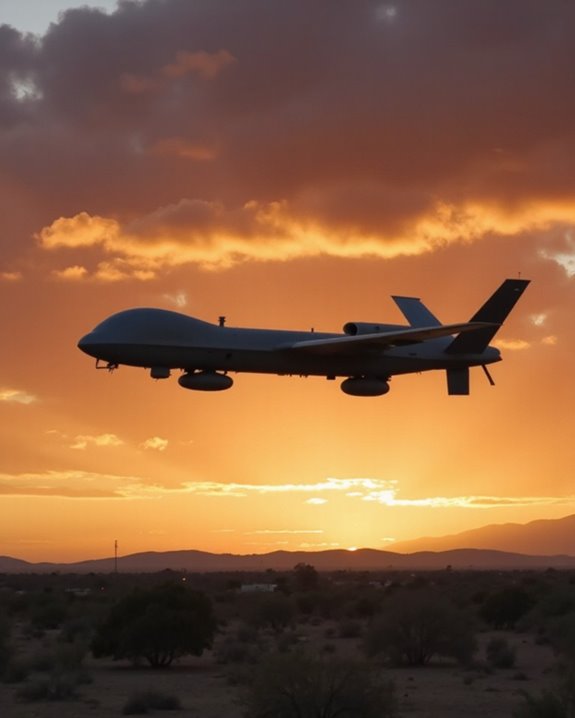Military drone flight times vary dramatically across different platforms. Tactical UAVs like the Skydio X2D operate for about 35 minutes, while medium-sized systems such as the Bayraktar TB2 can sustain flights up to 27 hours! The record-holder? Airbus’s remarkable Zephyr 8, which stayed aloft for an astonishing 64 days at 60,000 feet. Flight duration depends on factors like battery type, payload weight, and aerodynamic design. The evolution of solar power and hybrid propulsion promises even longer missions ahead!
Key Takeaways
- Military drone endurance varies widely, with the MQ-9B SkyGuardian achieving up to 40 hours of continuous flight.
- The Zephyr 8 holds the record with a remarkable 64-day flight at 60,000 feet altitude using solar power technology.
- Fixed-wing military drones generally offer longer endurance than rotary models, with Global Hawk reaching 32 hours.
- Battery type, payload weight, temperature conditions, and aerodynamic design all significantly impact drone flight duration.
- Smaller tactical drones like the RQ-11 Raven offer shorter flight times but provide crucial operational flexibility in the field.
The Range and Endurance Capabilities of Modern Military Drones
The evolution of military drone technology has revolutionized aerial warfare with remarkable advances in flight duration and operational range. Today’s premier UAVs showcase astonishing capabilities, with the MQ-9B SkyGuardian leading the pack at an impressive 40-hour endurance and nearly 7,000-mile range! This persistent presence in contested airspace raises significant Ethical Considerations regarding surveillance and power projection across international boundaries.
While International Standards continue evolving to address these concerns, engineers keep pushing the envelope. The TAI Anka and Bayraktar TB2 now match the original Reaper’s 27+ hour endurance, creating a new normal for persistent ISR missions. The trade-off between payload capacity and flight time remains a fascinating challenge, with manufacturers constantly balancing weight, power, and operational requirements. The RQ-11 Raven UAV, with its advanced sensor packages and 10-kilometer operational range, exemplifies the balance of lightweight design and effective battlefield reconnaissance in modern military drones.
Record-Breaking Flight Durations: Zephyr 8 and Beyond
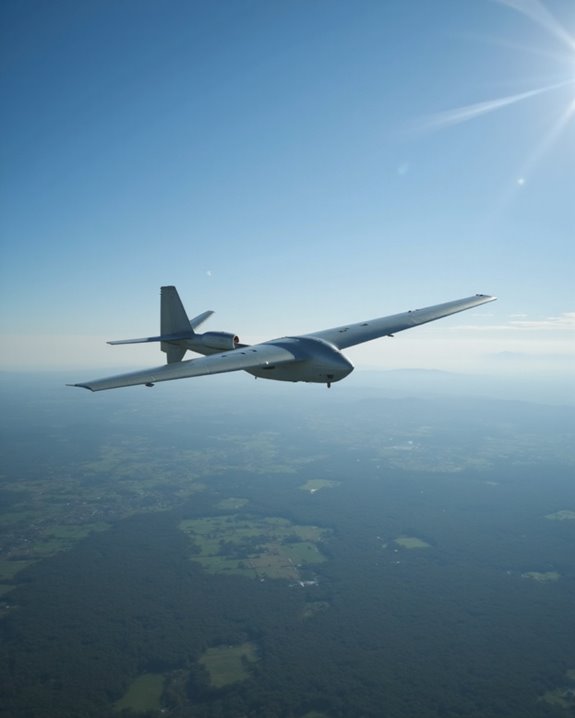
While standard military drones impress with endurance measured in dozens of hours, record-breaking stratospheric UAVs like the Zephyr 8 operate in an entirely different league of persistence!
This solar-powered marvel shattered all previous records with a jaw-dropping 64-day flight, cruising at a breathtaking 60,000 feet above Earth. The Historical Significance cannot be overstated – the Zephyr’s journey from QinetiQ’s 2003 drawing board to Airbus’s current record-holder represents nearly two decades of pushing endurance boundaries. Media Coverage of the flight highlighted how this “pseudo-satellite” covered an astonishing 56,000 kilometers while providing reconnaissance capabilities equivalent to 25 cell towers! Despite ending abruptly due to an “unexpected event” near Yuma Proving Ground, the mission generated 1,500 hours of valuable stratospheric data that will shape future military drone capabilities. Talk about staying power! Modern military-grade drones often incorporate features such as extended flight time and advanced stabilization systems to maximize operational effectiveness.
Factors Affecting Military Drone Flight Time
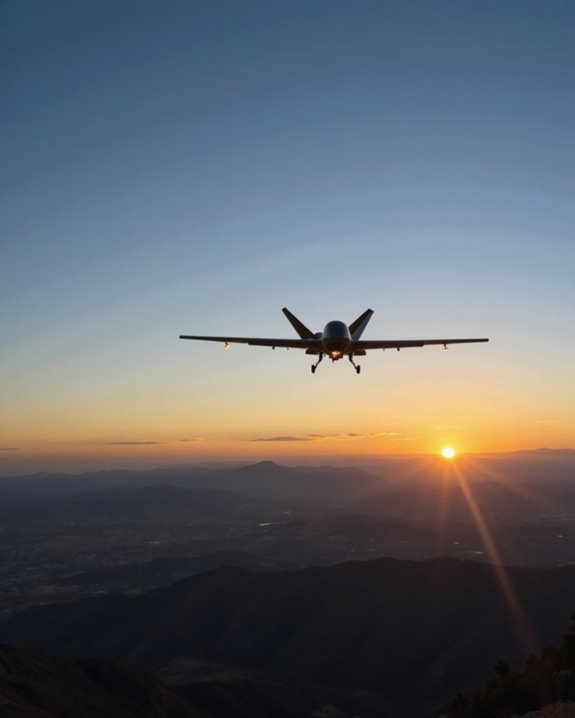
Military drone endurance isn’t simply about having the biggest battery! A complex interplay of factors determines how long these aerial sentinels can remain aloft. Battery Type greatly impacts performance, with advanced lithium-ion configurations offering superior energy density compared to older technologies. Temperature Effects can’t be overlooked either, as extreme heat or cold can dramatically reduce battery efficiency—sometimes by up to 40%! Environmental conditions like wind resistance and air density create additional challenges, while payload weight from cameras and sensors acts like unwanted baggage on a long trip. The drone’s physical design, including aerodynamic properties and material selection, further influences flight duration. Even operational decisions matter! Strategic altitude management and cruise speed optimization can help military operators squeeze every precious minute from their unmanned aircraft, making the difference between mission success or an untimely return to base. Additionally, some military drones leverage hybrid gas-electric power to achieve longer flight durations with improved fuel efficiency.
Comparing Flight Times: Fixed-Wing vs. Rotary Drone Platforms
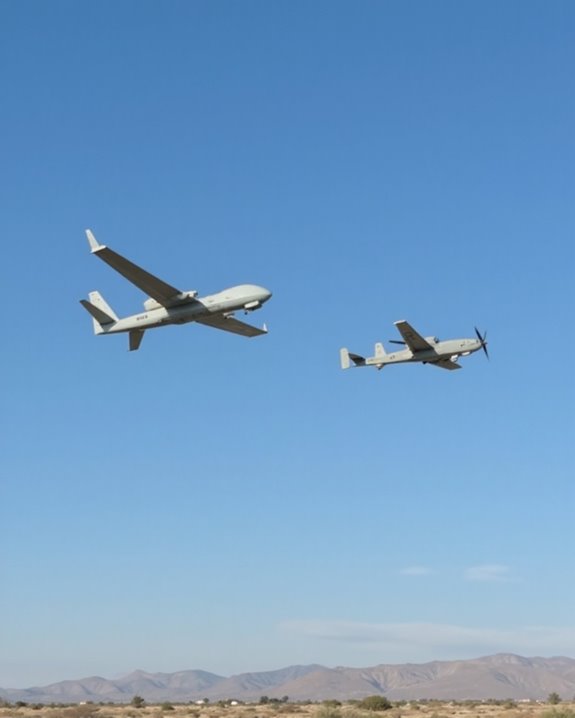
Fixed-wing and rotary drone platforms represent two fundamentally different approaches to military aerial surveillance, with dramatically contrasting flight durations that shape their mission capabilities. The difference is stunning – while a Global Hawk can stay aloft for up to 32 hours at 60,000 feet, rotary drones like the Skydio X2D manage just 35 minutes per battery cycle!
This disparity stems partly from their distinct Takeoff Methods. Fixed-wings need runways but gain incredible efficiency once airborne, while rotary platforms can lift vertically from almost anywhere – trading endurance for flexibility. Landing Techniques follow similar patterns; fixed-wings require prepared surfaces or specialized recovery systems, while rotary drones can touch down precisely in tight spaces. It’s a classic case of “you can’t have your cake and eat it too” in military aviation!
Solar-Powered Revolution in Extended Drone Operations
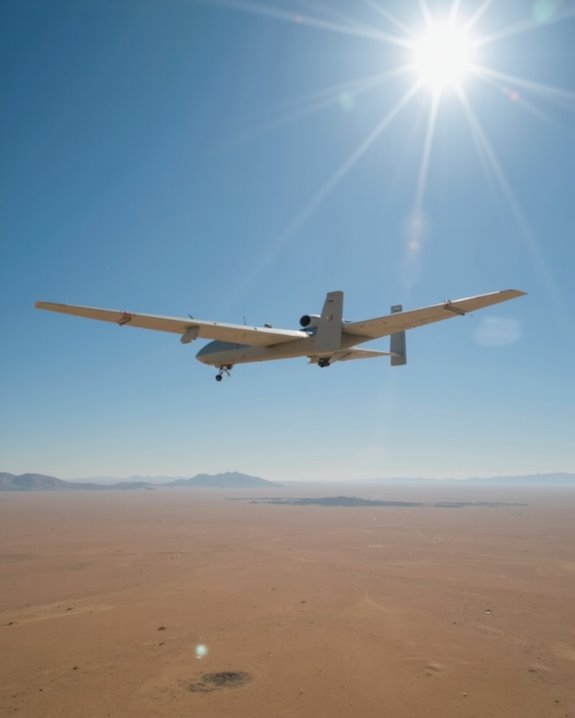
The limitations of conventional drone flight times have sparked a remarkable breakthrough in recent years – the solar-powered revolution! Military drones like the Zephyr 8 have shattered endurance records, staying aloft for an astonishing 64 days while covering nearly 35,000 miles. Talk about game-changing technology!
These solar marvels, with their carbon fiber construction and wing-integrated solar panels, raise fascinating Ethical Debates about persistent surveillance capabilities. The Skydweller drone, with its impressive 236-foot wingspan, demonstrates how far we’ve come, completing 22.5-hour continuous flights during testing.
Advanced battery systems featuring hibernation modes help these drones weather low-light conditions, though Regulatory Challenges remain concerning airspace management for these perpetual flyers. Who would’ve thought that combining sunshine and military technology could keep eyes in the sky for weeks at a time?
Mission-Specific Endurance Requirements for Combat Drones
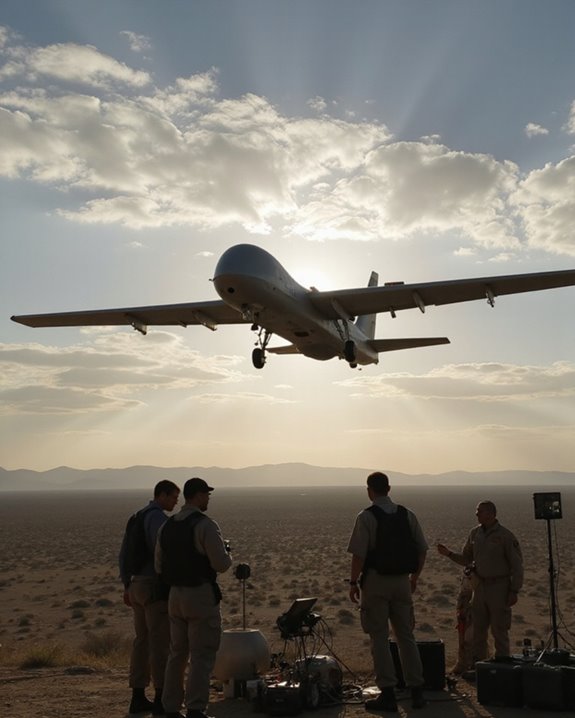
When combat missions demand precise capabilities, drone endurance becomes a critical battlefield factor that can mean the difference between success and failure! The MQ-9 Reaper‘s impressive 27-hour flight time enables extended surveillance missions, while the MQ-4C Triton‘s 30-hour endurance makes it perfect for maritime patrol operations. Tactical Strategies often revolve around matching the right drone to each mission profile.
Even the RQ-170 Sentinel, with its shorter 5-6 hour flight duration, serves an essential intelligence role where extended loitering isn’t the priority. Logistics Planning must account for variables like weather conditions and terrain, which can dramatically reduce a drone’s effective endurance. Commanders chuckle when rookies forget this golden rule: it’s not just how long a drone can fly—it’s how effectively it can complete its specific mission!
Future Innovations Extending Military Drone Flight Capabilities
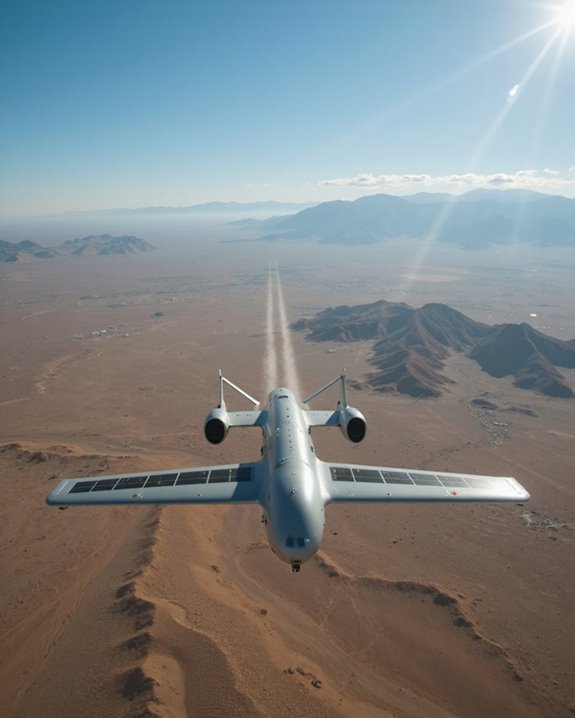
Breakthrough technologies are rapidly transforming military drone capabilities, pushing flight times beyond what analysts thought possible just a decade ago! The integration of Hybrid Propulsion systems combines traditional combustion engines with electric motors, dramatically extending operational ranges while reducing fuel consumption. These innovations, paired with Bio-inspired Designs that mimic efficient flying creatures like birds and insects, are revolutionizing aerodynamics.
Lightweight materials and AI-driven navigation systems are working together to maximize every minute in the air. The JOUAV CW-30E, with its impressive 600-minute flight time, shows just how far we’ve come! Smart payload management and swappable equipment mean one drone can now handle multiple mission types without returning to base. Who knew that batteries designed for smartphones would eventually help our military drones stay aloft for days?
Frequently Asked Questions
How Do Extreme Weather Conditions Impact Military Drone Flight Times?
When dark clouds gather, trouble follows. Extreme weather drastically reduces drone flight times through humidity effects that damage electronics and wind interference that increases power consumption, forcing drones to land prematurely or risk mission failure.
Can Military Drones Be Refueled or Recharged Mid-Flight?
Most military drones cannot currently be refueled mid-flight. While Refuel Innovations are in development, operational systems remain limited. Researchers are exploring aerial Charging Methods, but practical implementation faces significant technical and safety challenges.
What Training Do Military Drone Pilots Need for Long-Duration Missions?
While civilian pilots rest, military drone operators train relentlessly. Their preparation includes extensive simulation training for extended operations and stress management techniques to maintain focus during long-duration missions spanning multiple shifts.
How Are Drone Operators Rotated During Extended Surveillance Operations?
Military drone operators rotate through structured shifts with designated handover procedures. Teams implement fatigue protocols including mandatory rest periods, regular breaks, and health monitoring to maintain operational effectiveness during extended surveillance missions.
What Happens if a Long-Range Military Drone Malfunctions Over Hostile Territory?
Despite advanced safeguards, drone malfunction over hostile territory triggers immediate emergency protocols. Ground crews attempt remote recovery while specialized teams plan hostile retrieval operations, often using diplomatic channels alongside military options to minimize technology compromise.

